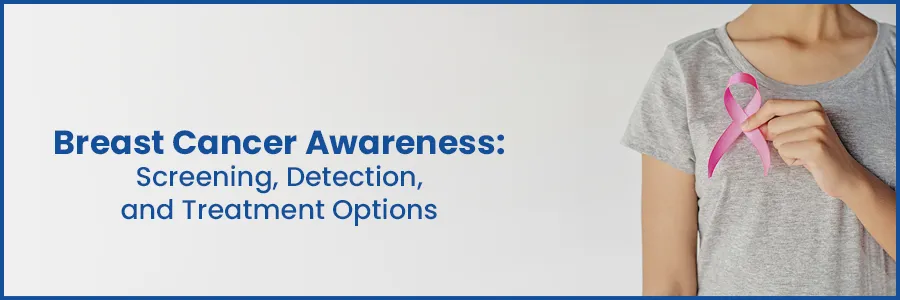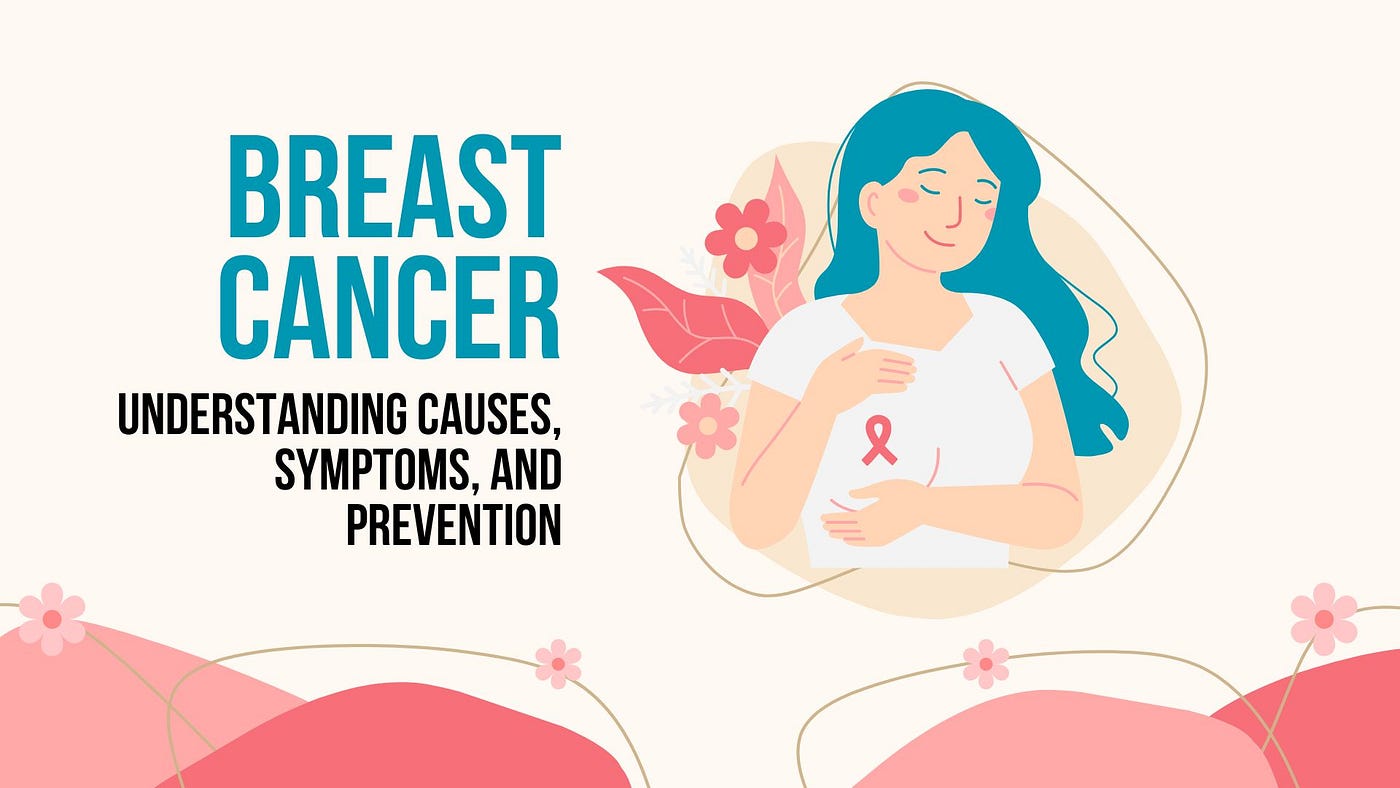Understanding Breast Cancer: Symptoms, Risk Factors, and Prevention
Introduction
Unraveling the Mysteries of Breast Cancer
Breast cancer is a topic of utmost importance, and understanding it is crucial for everyone. In this article, we will delve deep into the intricacies of breast cancer, shedding light on its symptoms, risk factors, and prevention methods. Let’s start by acknowledging the significance of breast cancer awareness and education.
Understanding Breast Cancer
What Is Breast Cancer?
Breast cancer is a complex disease that develops when cells in the breast start to grow uncontrollably. It can affect both women and men, although it’s more common in women. In this section, we will define breast cancer, its significance, and why it’s essential to know about it.
-
Types of Breast Cancer

Breast cancer comes in various forms, such as ductal carcinoma and lobular carcinoma. Each type has its characteristics and implications. We will explore these different types, helping you understand the nuances of breast cancer.
Breast Cancer Statistics

The Prevalence of Breast Cancer
Breast cancer is a pervasive and significant health concern globally, affecting individuals of all ages, genders, and backgrounds. Understanding its prevalence is essential for public health awareness and proactive healthcare management.
- Global Impact: Breast cancer ranks among the most commonly diagnosed cancers worldwide. It affects millions of people each year, making it a considerable public health challenge. The prevalence of breast cancer varies by region and demographic factors, but its impact is felt universally.
- Incidence Rates: Breast cancer incidence rates vary among different countries and regions. Factors such as genetics, lifestyle choices, and access to healthcare services contribute to these variations. Developed countries often report higher incidence rates, but the disease affects individuals from all walks of life.
- Age and Gender: While breast cancer is more commonly associated with women, it can also occur in men, albeit at much lower rates. The prevalence of breast cancer in women increases with age, particularly after menopause. Regular breast cancer screening is essential for early detection, as age is a significant risk factor.
- Risk Factors: Understanding the prevalence of breast cancer involves recognizing the various risk factors associated with the disease. These include family history, genetic mutations (e.g., BRCA1 and BRCA2), hormonal factors, lifestyle choices (such as diet and physical activity), and exposure to environmental toxins. By identifying these risk factors, individuals can make informed decisions about their health and risk reduction strategies.
- Awareness and Early Detection: Increasing awareness about breast cancer prevalence is vital for promoting early detection and better outcomes. Regular breast self-exams, clinical breast exams, and mammography screenings are essential tools for detecting breast cancer in its early stages when it is most treatable.
- Research and Advancements: Ongoing research efforts are aimed at better understanding the prevalence of breast cancer and improving treatment options. Advances in genetic testing, targeted therapies, and immunotherapy offer hope for more effective and personalized treatments, ultimately reducing the impact of the disease.
- read more about Balancing Hormones Naturally: Tips for Women’s Health
Symptoms of Breast Cancer

Recognizing the Warning Signs
Early detection is key to successfully treating breast cancer. In this section, we will list and describe the common symptoms of breast cancer. Recognizing these warning signs could save lives.
-
Early Detection Saves Lives
We can’t emphasize enough the importance of early detection. By understanding these symptoms, you can take proactive steps to seek medical attention when needed.
Risk Factors

Factors That Increase Breast Cancer Risk
Several factors can increase the risk of developing breast cancer. These include genetics, lifestyle choices, and more. We’ll enumerate the key risk factors and help you assess your own risk.
-
Family History and Genetics
Family history and genetics can significantly contribute to breast cancer risk. We will discuss how your family’s medical background and genetic factors may influence your chances of developing this disease.
Prevention and Screening

Reducing Your Risk
Preventing breast cancer is a priority for many. In this section, we will provide practical tips and lifestyle changes that can help reduce your risk of breast cancer.
-
The Importance of Regular Screening
First and foremost breast cancer is a complex disease that can develop silently and progress rapidly without noticeable symptoms. This fact underscores the critical role that regular screening plays in early detection and effective management.
Additionally it’s essential to understand that breast cancer doesn’t discriminate; it can affect individuals of all ages and backgrounds. Furthermore it’s a disease that, when detected in its early stages, is often more treatable and associated with better outcomes.
Moreover regular breast cancer screening primarily involves mammograms, specialized X-ray examinations designed to detect abnormalities in breast tissue. These mammograms are a cornerstone of early detection, offering a window into the breast’s inner workings long before physical symptoms manifest.
In addition to mammograms, regular breast self-exams and clinical breast exams by healthcare providers are valuable components of a comprehensive screening regimen. These examinations work in conjunction with mammography, creating a multi-pronged approach to early detection.
Furthermore, adhering to a routine screening schedule is crucial. Consequently, individuals should follow the screening recommendations provided by their healthcare professionals, typically starting with mammograms at age 40 and continuing annually or as advised.
Moreover, regular screening isn’t solely about identifying breast cancer when it’s present; it’s also about reducing the number of advanced-stage diagnoses and enhancing treatment outcomes. By catching breast cancer at an earlier, more manageable stage, patients have a broader range of treatment options and a higher likelihood of successful recovery.
Ultimately, the importance of regular breast cancer screening cannot be overstated. It’s a proactive and preventative measure that empowers individuals to take control of their breast health. With early detection comes the potential for less aggressive treatments, improved quality of life, and, most importantly, higher survival rates. So, making regular screening a part of your healthcare routine is a proactive step towards ensuring your well-being.
Treatment Options

Breast Cancer Treatment Approaches
Breast cancer treatment options encompass a range of strategies tailored to the individual’s specific diagnosis and needs:
- Surgery: Surgery is often the primary treatment for breast cancer. It involves removing the cancerous tumor and, in some cases, nearby lymph nodes. There are different types of surgeries, including lumpectomy (removal of the tumor and surrounding tissue) and mastectomy (removal of the entire breast).
- Chemotherapy: Chemotherapy uses drugs to kill cancer cells or stop their growth. It can be administered orally or intravenously and is typically used after surgery to reduce the risk of cancer recurrence. Chemotherapy can have side effects, such as nausea and hair loss, but advances in medical science have led to more targeted and less toxic treatments.
- Radiation Therapy: Radiation therapy uses high-energy rays to target and kill cancer cells. It is often used post-surgery to destroy any remaining cancer cells and reduce the risk of recurrence. Radiation therapy is a localized treatment and may cause side effects like fatigue and skin changes in the treated area.
- Hormone Therapy: Hormone therapy is primarily for breast cancers that are hormone receptor-positive. It aims to block hormones like estrogen that fuel the growth of certain breast cancers. This treatment can be in the form of pills or injections and is typically taken for several years.
- Targeted Therapy: Targeted therapy drugs are designed to specifically target cancer cells or their pathways while sparing healthy cells. They are often used in combination with chemotherapy or hormone therapy for more effective treatment with fewer side effects.
- Immunotherapy: Immunotherapy is a newer approach that enhances the body’s immune system to recognize and attack cancer cells. It’s being researched for its potential in treating breast cancer, particularly in cases where other treatments may not be effective.
- Clinical Trials: Participation in clinical trials can provide access to cutting-edge treatments and therapies that are still under investigation. These trials help advance the field of breast cancer treatment and offer hope for improved outcomes.
- Personalized Treatment Plans: Breast cancer treatment is increasingly tailored to the individual patient. Personalized treatment plans consider factors like the type of breast cancer, its stage, genetic markers, and the patient’s overall health. This approach ensures the most effective and least invasive treatment is chosen.
Remember that the choice of treatment depends on various factors, including the stage and type of breast cancer, as well as the patient’s overall health and preferences. It’s crucial to consult with a healthcare team to determine the most suitable treatment plan for each unique situation.
Living with Breast Cancer
Emotional and Practical Support
Being diagnosed with breast cancer is emotionally challenging. We’ll offer guidance on managing emotions and seeking the practical support you need during this time.
-
Life After Breast Cancer Treatment
Life doesn’t stop after breast cancer treatment. In this section, we will discuss what comes next, including potential challenges and how to navigate them.
FAQs (Frequently Asked Questions)
FAQ 1: What Are the Early Signs of Breast Cancer?
We answer the most common question by providing detailed information about early signs and advice on what to do if you notice them.
FAQ 2: Can Men Develop Breast Cancer?
Breast cancer isn’t limited to women. We provide information on breast cancer in men, helping to raise awareness about this less-discussed aspect.
FAQ 3: Are There Natural Ways to Reduce Breast Cancer Risk?
Many people wonder about natural prevention methods. We discuss these strategies and their effectiveness.
FAQ 4: What Are the Latest Advances in Breast Cancer Treatment?
Medical advancements are continually improving breast cancer treatment. We highlight the latest breakthroughs in the field.
FAQ 5: How Can I Support a Loved One with Breast Cancer?
Supporting a loved one through a breast cancer diagnosis can be challenging. We offer valuable advice on how to be there for someone battling breast cancer.
Conclusion
Empowering Knowledge Against Breast Cancer
In conclusion, this article has explored the multifaceted world of breast cancer, covering its symptoms, risk factors, prevention, treatment, and emotional aspects. Empowered with this knowledge, you can take proactive steps towards early detection and a healthier future.








 Viesearch - The Human-curated Search Engine
Viesearch - The Human-curated Search Engine
